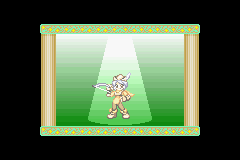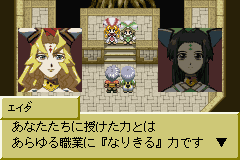|
|

|
PLATFORM
|
GBA
|
BATTLE SYSTEM
|

|
INTERACTION
|

|
ORIGINALITY
|

|
STORY
|

|
MUSIC & SOUND
|

|
VISUALS
|

|
CHALLENGE
|
Hard
|
LANGUAGE BARRIER
|
Moderate
|
COMPLETION TIME
|
20-40 Hours
|
|
OVERALL

|
+ Twenty-two different allies.
+ Two hundred different costumes.
+ Battles are fast-paced and challenging.
+ Excellent character scenes.
+ A good amount of exploration.
- Sudden spikes in difficulty.
|
Click here for scoring definitions
|
|
|
Tales of the World: Narikiri Dungeon 2 has a lot of firsts to its name. It's the first of the "escort" Tales games to be a true spinoff instead of a sorta-sequel (like the first Narikiri). It's also the first Tales of the World title, despite the numeral in its name. Finally, it's the first game with the linear battle system to be outsourced — in this case, to Hi-no-Kuni's own Alfa System.
The player takes control of two protagonists, Frio and Calo, who have received an important mission from the goddesses that watch over their mismatched world. Something or someone is out there, riling up the monsters and leading the world into a repeat of the disaster that nearly brought destruction upon creation a millennium before. As the champions of the goddesses, Frio and Calo gain the power of narikiri, or quick-change. Whatever costume they wear determines their current abilities.
Individual costumes can be bought, leveled up, enhanced, or altered into new forms. This game has a total of two hundred costumes available, including all gender- and element-based forms, and there exists plenty of motivation to expand the collection. Any one costume can inherit up to three bonus abilities from previous forms. These bonuses are permanent, so some thought must be put into the process. Minor costumes cannot be ignored, as ones like the merchant, musician, or cat-girl outfits have excellent support traits built into them. Certain costumes are also necessary to unlock some of the twenty-two cameo characters present in the game.
Foregoing the usual epicly linear plotline found in most Tales games, the writers at Alfa System built up a scenario entirely around small vignettes. There are only a handful of necessary events in the entire game, with the rest filled in with minor quests provided by NPCs and cameo characters. While most of these fit into the "find item Y," "kill monster X," or "locate character Z" models, they often come as a series of interrelated events centering on one or more NPCs. Even a total failure can lead to more opportunities, as whoever is sent to finish the job in the player's stead might himself end up needing to be rescued.
 Dine-and-dash is a crime, y'know. Bad Arche!
Dine-and-dash is a crime, y'know. Bad Arche!
|
|
As a game built up around character cameos and crossovers, there are all sorts of ways that Narikiri 2 could have gone wrong, except that it didn't. The cameo characters are pulled from three Tales games (Phantasia, Destiny, and Eternia), and the way they interact with each other and with the game's NPCs is hilarious. Arche the witch (Phantasia) irks the owner of the local pub with her dine-and-dash tactics. Phillia (Destiny) bores people half to death in the local school. Ridd (Eternia), Stan (Destiny), and Cress (Phantasia) get into a competition of swordsmanship, which the pub owner cheerfully uses as a means to get all of her vegetables chopped in time for dinner. And then there's the time Keele (Eternia) found Klaus's (Phantasia) private copy of "Hot-Blooded Witch Babes" (meant for research only, honest). All these scenes help to keep Narikiri 2 soaring above the tedium one might expect of a title composed ninety percent of random quests.
And then there's Thanatos. If a story is only as strong as its villain, then this game as an excellent tale to tell. While he only appears six times in the game, and only twice in the flesh, Thanatos has solid writing and excellent motivations to back him up. Every mission involving him presents the player with a significant spike in difficulty as well as the only times where defeat means game over, making success that much sweeter.
 When class-changes are crossed with a fashion show, this is what you get.
When class-changes are crossed with a fashion show, this is what you get.
|
|
Narikiri 2 has nine dungeons, with most of the action occurring in the middle seven between the beginner's area and the final level. These seven dungeons have multiple, branching areas within them, and the overall difficulty increases as the game progresses, so that they remain fresh and challenging up to the end. There are three optional bosses (Valkyrie, Dhaos, and Celsius) hidden within them, each of whom provides a challenge surpassing even the final boss.
Of its three contributing games, Narikiri 2 most closely resembles Tales of Eternia in terms of graphics. Battle sprites for Eternia characters are nearly identical to the originals, and all the Phantasia and Destiny characters have been altered to fit the same style. This means that Narikiri 2 successfully avoids the bobblehead syndrome of the earlier games, much to its benefit. The game also has original sprites for characters / costumes not normally seen, like the Mr. Driller or Dymlos outfits. Character portraits remain closer to their originals, which results in some odd differences in style, but otherwise the game's graphics come together quite nicely. Likewise, the music fits the setting well, with area, battle, and boss themes all sounding good even on the GBA's speakers.
This title would be of moderate difficulty for importers to understand, but there aren't many issues that a bit of trial and error (and judicious note-taking) might fix. The gameplay difficulty is another matter. The game's six plot-important missions can all be delayed, allowing the player to level up indefinitely, but there's a level cap of 60 in effect, even at which point the final boss will be a major challenge.
 Hel-LO Goddess!
Hel-LO Goddess!
|
|
For an outsourced, third-party, derivative, secondary series entry for a technologically inferior handheld, Narikiri 2 succeeds in being just as good as its main-series predecessors — albeit for different reasons. While it caters heavily to the Tales fandom, it doesn't skimp on the actual gameplay one bit. It could have stood to be a little easier at the end, but at least it wasn't a cakewalk either. Alfa System definitely did a good job on this one.
Review Archives
|









